Top ratings
Get free trial access now Try first, then study!

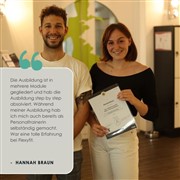
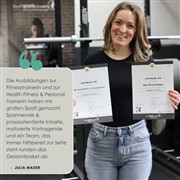
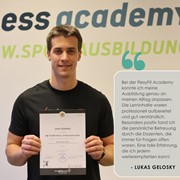

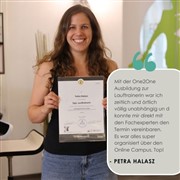
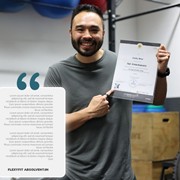

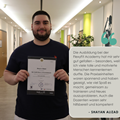
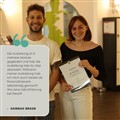
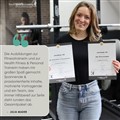
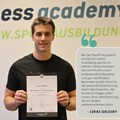
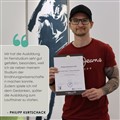
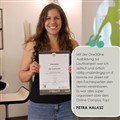
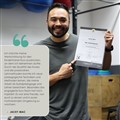
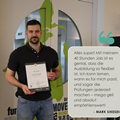

€ 2.090,- | Classroom Courses
» Our Course Packages
Important informations
Recognized & Certified
Our graduates, partners & friends say
Our team will be happy to advise you at any time by phone, chat or in person
Behind every top athlete is a professional support team (physiotherapists, sports masseurs and sports physicians).
Fitness and health are also becoming increasingly important for many recreational athletes. A sports massage is essential for an active athlete. Sports massage is of great importance both before and after a competition or intensive sporting activity.
The most important thing a sports masseur has to do is loosen up the athlete's muscles. The massage relaxes the muscles and improves blood circulation. As a result, the muscles recover more quickly and injuries are prevented. A sports massage should also be individually tailored to the respective athlete and their needs.
Incidentally, this training can be optimally supplemented with other courses such as fitness trainer, personal trainer or medical sports supervisor.
Legal note: The practical application of the knowledge acquired in this course requires an existing professional license, for example as a commercial masseur or medical masseur. If the course is taken as an individual course, the knowledge acquired may only be used for private purposes, in the context of family and neighborhood assistance or within an employment relationship. The training courses offered serve exclusively to impart knowledge and skills for use on healthy people. No medical therapies are taught or practiced. The content of the events does not constitute medical training and is no substitute for medical or therapeutic treatment. Participants are responsible for ensuring that the knowledge and skills acquired are applied in accordance with the applicable legal provisions.
Target group of the training: The training is aimed at people interested in sports, athletes and those who have already completed a basic course in classical massage. It is also suitable for commercial masseurs, medical masseurs, medical-technical specialists, therapeutic masseurs, sports scientists, sports teachers, physiotherapists and doctors who wish to expand their knowledge.
Extent of learning
588 E
EQF level
The training is based on EQF level 4 »
Course start
Possible immediately
Learning variant
Classroom Courses
Available
Languages

| 03-01-2026 | € 2.090,-
| 03-01-2026 | € 2.090,-
| 03-01-2026 | € 2.090,-
| 22-12-2025 | € 2.090,-

Sports massage describes a specialized form of massage adapted to the requirements of sports. The goal of a massage is to promote and activate circulation in specific body areas or to relax them. This goal is achieved through the application of specific techniques on the affected body parts.
As a sports masseur, you support athletes in their training by improving circulation, loosening muscles, and inducing increased alertness with pre-activity massages.
After training, you assist athletes with recovery massages. These relaxing massages are used for calming purposes and are applied after physical activity. Their goal, besides improved recovery, is the physical and psychological coping with the performance achieved.
For the care of athletes, it is important for sports masseurs to understand the changes in the body due to sports. Therefore, you will learn how sports massages optimize metabolic processes in the muscles and shorten recovery time after physical exertion.
Both massage and self-massage will be part of the course content. Differentiating between pre-activity massages and recovery massages, we will show you the correct application and dosage of techniques, demonstrate how to conduct functional tests, and much more.
Taping is also an essential part of this training. Both functional taping and kinesio taping are extensively covered and applied in practice.
Our certificates are globally recognized and are issued in various versions. Upon request, you will receive our certificate in multiple languages (DE, EN, ES), with country-specific information, and with or without grading.
All these versions are available for free download online. In addition, depending on the learning package you have acquired, you will receive a certificate of your choice printed on special paper with embossing.
The following diploma (in multiple languages DE, EN, ES) is awarded:
We are happy to assist you via contact by phone, email, or chat. You may also find the answer to your question in our general FAQ or Sports Masseur FAQ.
Extent of learning
200
Sports expertise
350
Presence | Self-study
6
Literature research
30
Practical realization
2
Additional tasks & examinations
Our training courses are generally eligible for funding. The relevant funding body will decide whether you are eligible for funding.
We will be happy to support you in compiling all the necessary course information you need for your funding application.
Of course, we will be on hand to advise you throughout the entire process and support you from the initial inquiry to the submission of your application. Contact us - we will make sure that you are as well prepared as possible!
Show all chapters of the subjects

We educate the best trainers in the fitness branch. From start to finish of the education - and beyond!- we support and guide our students.
Functional anatomy is a foundation necessary for all trainers in exercise, fitness and sports. This subject provides a comprehensive introduction to the anatomy of the human body and a wellspring of important knowledge.
The course is constructed to present the information in an interesting and comprehensible manner and features different learning approaches appropriate for Fitness and Personal Trainers.
The goal is, to understand the relationship between movement patterns, the human body and relevant anatomical terminology.

Our participants are introduced to the basics of sports nutrition.
As a foundation the composition of general nutrition including macro and micro nutrients, as well as the water balance, are discussed. In order to understand various correlations, the energy metabolism are explained in detail.
In addition, the effects of individual food components in the human body, as well as their importance in sports are covered.


More and more companies are integrating Corporate Wellness and similar health initiatives into their employee benefits packages. By doing so they promote the health and well-being of their employees, reducing the incidence of sick-leave and building healthier, stronger team dynamics.
Exactly why such initiatives are important is discussed in this introduction to the concept, as well as challenges that such initiatives face including organisational dysfunction.
Participants also learn about the advantages of corporate wellness and some trusted approaches and tools for finding and working with a company.
We offer suggestions on how to approach companies about Corporate Wellness, how to develop a corporate wellness concept and important organisational points to consider.
Participants will be exposed to some practical examples and will have the possiblity to perform group work on the topic.

The unit on Marketing and Customer Interaction gives participants some insight into identifying, working with and marketing to their ideal customer. This is one of the most useful units for the aspiring trainer, as it helps them identify their place in the market, which makes for a more successful career start.
We begin by taking a look at Marketing itself to understand exactly what it is and of what relevance it has for personal trainers.
Important basic concepts such as USP, positioning, target market, etc. are introduced and different models from marketing such as the SMART Formula, marketing mix (7Ps) and more are explained.
The communication between trainer and client is also addressed in this unit. Various aspects of communication theory and some guidelines for successful communication are covered.
Upon completion of this subject, participants are able to develop marketing strategies for their product and/or services, ready to position themselves in a market rich in variety and full of possibility!

A working understanding of human physiology and therefore the relationships between the various functions of the human body is crucial for anyone working in the exercise and fitness field. It is a requisite knowledge for the sufficient practice of their profession.
This course makes the relationships within the human organism graspable for everyone. Take a deep-dive into the human body and learn the functions of our organism for your new profession in fitness.
In this subject you will get a close look at energy metabolism needed for muscle activation, the circulatory system and the pulmonary system.
Any high quality education in fitness and exercise begins with the foundations of anatomy and physiology.

In this unit participants are prepared for successful communication with their clients on every level. In addition, we take a look at how the trainer or coach can go about dealing with their own goals and motives, which will in turn help them better understand their clients.
The right goal-setting and the proper approach to feedback are an important parts of this unit.
The way we manage stress as trainers and with our clients and a variety of learning strategies are explored so these skills can be integrated into your professional approach.

The first part of training theory teaches the basics of training, such as training principles, principles of training design, training methods and the factors of athletic performance.
As performance, performance diagnostics, training and competition are closely interrelated, they are also taught accordingly in the course.
In the second part of training theory, training is defined and evaluated as a complex action process and in connection with planning, execution and evaluation.
An important part of training theory is still the design of training plans, which is taught in practice with examples of the possibilities of designing a training plan.
In order to delve even deeper into training science, we have worked with top international speakers such as Prof. em. Dr. phil. Dr. med. Dr. h.c. Jürgen Weineck, we have also developed a video workshop on the subject of altitude training.
Show all chapters of the subjects

Whether, when and who may be massaged is strictly regulated by law. And rightly so, as masseurs work directly on the body!
For this reason, the Diploma Sports Masseur training course also explains trade law guidelines so that participants know who they are allowed to practice on after completing the course. The meaning of sports massage and how it differs from other massage practices is explained in detail.
But of course it is not just the legal aspect that is highlighted. Diseases of the skin or acute injuries are also discussed together so that it can be assessed in future whether or not people may be massaged.
This is why the medical history takes up a large part of the course. Our participants learn to recognize complaints and misalignments and, based on this, to assess the correct positioning of the client as well as the application and dosage of massage techniques.
Sports masseur training is a fantastic addition to other sports training and coaching activities, especially, but not only, in the competition sector.



Functional taping is intended to relieve pain and support the muscles in the event of injuries. Kinesio taping is a special type of taping that promotes blood circulation and strengthens the muscles. Both types of taping can be used for many different sports.
The application is then very practice-oriented. From measuring to placing the bandage, participants learn all the important intermediate steps.
The trainers also learn how to apply ankle bandages, support bandages, relief bandages and much more. They also learn how to apply kinesiotape to specific muscles. Among other things, this helps with changes in tone, muscle control and the elimination of circulation restrictions.

In the abdominal/chest massage subject of the sports masseur training course, both self-massage and functional massage are explained in more detail. The techniques taught are particularly valuable in the sports areas of climbing, boxing and weight training, as sporting activities are often associated with tension in this area.
Massages in the chest area also support the activation and strengthening of the auxiliary respiratory muscles.
The colon massage according to VOGLER and KRAUSS is also covered in this subject. This technique is a manual, anal pressure and gliding movement on the colon, which is performed at five anatomically defined points on the abdomen. It is used to create a balanced, normal muscle tone in the abdomen with an effect on the circulation and the autonomic nervous system.
As with all our training courses, whether distance learning, face-to-face courses or One2One lessons, it is important to us that what we learn is carried out safely. We therefore naturally also discuss in which cases the massage techniques should be modified or not performed at all.

In the massage area of the legs and buttocks, the focus is on prominent bony points, superficial muscle courses and other structures that are important for orientation during a massage treatment or anamnesis. This is where anatomical knowledge of attachment and origin points or regions of muscles becomes essential in sports therapy, which is part of all our training courses.
Especially for sports that almost exclusively require strength and endurance of the lower extremities, such as running, cycling, soccer and long jump, a sports massage of these areas can be of great benefit. Disorders in the foot can also have an effect on the pelvis and spine, which can lead to pain in other parts of the body.
Knowing how to perform massages correctly in this very sensitive area is therefore essential in sports massage.


In the massage area of shoulders and arms, participants of the Diploma Sports Masseur course learn various self-massage techniques. From the hand technique to the finger technique to the pressure-movement technique, various techniques are presented. These not only have various applications, but also delay hand fatigue, allowing for a longer massage.
Massage using massage balls, massage fairies and fascia rolls is also an important part of the training.
Finally, implementation in specific sports is discussed. Using the case study of a golfer, a handball player and a tennis player, massage techniques after training or competition and common injuries are analyzed.


In this part of the sports masseur course, participants learn how to prevent injuries through warm-up exercises and injury prevention.
Participants are given an overview of possible sports injuries to muscles, bones, cartilage, tendons and ligaments. The 18 most common sports injuries are also used to explain the symptoms, treatment and return to training.
Initial treatment using the PECH scheme rounds off this training subject: The PECH scheme teaches participants how to react correctly in an emergency. After all, quick and competent action is crucial in an emergency situation.

Available course variations
Language of Instruction
Course Module
Fitness Fundamentals
Fitness basics (presence)
Fitness Fundamentals Full HD Video Lessons
Course Module Full HD Video Lessons
Course Modality
Study Method
Auditory & Visual Learning Style
Communicative & Kinesthetic Learning Style
Study Timeframe
Text & Presentation PDFs
Lectures Bookable as Classroom Units
Support via Online Campus, E-mail, Chat, Tel.
WhatsApp & On-site Support
Test/Dummy Exam
NADA Austria
Altitude Training - Prof. Dr. Weineck
Fitness Fundamentals Theory Exams Online
Final Exam
Certificate in DE, EN or ES
Certificate accepted worldwide & never expires
Lifetime Access to Online Campus
Free Demo Account / Trial Package
Certificate Copy as Downloadable PDF
Certificate with Verification via QR-Code
Financial Aid/Grant Opportunities
Paid Educational Leave (AT)
Grants for Businesses
Grants for Self-Employed Persons
Course Advising
Cost Estimate for Financial Aid Provider
Job Openings Mailing List
Comprehensive Training Opportunities
Absolute Best Price & Service Offer
EN
Group attendance course
online
Optionally bookable
314
postable
online/presence
visual/motor
well suited
well suited
flexible + dates
contain
Flexible date
up to 100%
non-binding
There are a variety of funding options for training at the Flexyfit Sports Academy. State-specific and EU funding as well as tax-related options form the basis for this.
However, we would like to point out that the respective funding body is solely responsible for deciding on the allocation or amount of funding.
We will be happy to help you find a suitable funding body and compile all the course information you need for a funding application. You must submit the application itself to the funding bodies.
Depending on the funding institution, the training costs are either paid directly after the funding application has been confirmed (e.g. AMS) or reimbursed in full or in part after successful completion of the training (e.g. waff). Please contact the funding institutions yourself to find out how the funding works.
Yes, the majority of our courses are suitable for educational leave.
If you want to continue your education without terminating your employment, you can arrange educational leave with your employer. This means that you will be released from work for the duration of your training.
Plan your educational leave with us now! We will be happy to clarify your individual training requirements with you in a personal, non-binding consultation.
You can take your educational leave for a maximum of 1 year within 4 years - there are 3 options:
It is important that your employer agrees to you taking educational leave. You must provide evidence of the training plans issued by us to the extent of 20 hours per week in the case of full-time educational leave, or at least 10 hours in the case of part-time educational leave.
You must regularly provide evidence of the progress of your training. For example, in the form of examinations or confirmation of attendance, which you will receive from us.
A sports masseur looks after athletes and supports them in the areas of performance and regeneration. In addition to sports massage and fatigue relief massage, the areas of responsibility also include classic and kinesiotaping. Sports masseurs are also trained in the field of sports traumatology and competition preparation.
As a sports masseur, you can also use the sports massage alongside your work as a fitness and personal trainer to look after your clients in the areas of massage, activation or regeneration after training. If you want to become self-employed with the training, you would also need the medical masseur or therapeutic masseur.
There is a fairly broad salary range for masseurs in the fitness and health prevention sector. The gross income in a permanent position ranges from €1,400 to €4,000 per month, depending on the employer. This is often supplemented by tips, which do not have to be taxed.
In self-employment, the hourly rate naturally depends on the services you offer. Between €50 and €120 per hour for sports massages is a realistic range. However, if you are self-employed, you may also need premises.
We regularly list job advertisements from fitness studios on our Sportkarriere platform. There you can apply directly for jobs as a fitness trainer, branch manager, instructor or studio employee.

Sports massage describes a specialized form of massage adapted to the requirements of sports. The goal of a massage is to promote and activate circulation in specific body areas or to relax them. This goal is achieved through the application of specific techniques on the affected body parts.
As a sports masseur, you support athletes in their training by improving circulation, loosening muscles, and inducing increased alertness with pre-activity massages.
After training, you assist athletes with recovery massages. These relaxing massages are used for calming purposes and are applied after physical activity. Their goal, besides improved recovery, is the physical and psychological coping with the performance achieved.
For the care of athletes, it is important for sports masseurs to understand the changes in the body due to sports. Therefore, you will learn how sports massages optimize metabolic processes in the muscles and shorten recovery time after physical exertion.
Both massage and self-massage will be part of the course content. Differentiating between pre-activity massages and recovery massages, we will show you the correct application and dosage of techniques, demonstrate how to conduct functional tests, and much more.
Taping is also an essential part of this training. Both functional taping and kinesio taping are extensively covered and applied in practice.
Our certificates are globally recognized and are issued in various versions. Upon request, you will receive our certificate in multiple languages (DE, EN, ES), with country-specific information, and with or without grading.
All these versions are available for free download online. In addition, depending on the learning package you have acquired, you will receive a certificate of your choice printed on special paper with embossing.
The following diploma (in multiple languages DE, EN, ES) is awarded:
We are happy to assist you via contact by phone, email, or chat. You may also find the answer to your question in our general FAQ or Sports Masseur FAQ.
Extent of learning
200
Sports expertise
350
Presence | Self-study
6
Literature research
30
Practical realization
2
Additional tasks & examinations
Our training courses are generally eligible for funding. The relevant funding body will decide whether you are eligible for funding.
We will be happy to support you in compiling all the necessary course information you need for your funding application.
Of course, we will be on hand to advise you throughout the entire process and support you from the initial inquiry to the submission of your application. Contact us - we will make sure that you are as well prepared as possible!
Show all chapters of the subjects

We educate the best trainers in the fitness branch. From start to finish of the education - and beyond!- we support and guide our students.
Functional anatomy is a foundation necessary for all trainers in exercise, fitness and sports. This subject provides a comprehensive introduction to the anatomy of the human body and a wellspring of important knowledge.
The course is constructed to present the information in an interesting and comprehensible manner and features different learning approaches appropriate for Fitness and Personal Trainers.
The goal is, to understand the relationship between movement patterns, the human body and relevant anatomical terminology.

Our participants are introduced to the basics of sports nutrition.
As a foundation the composition of general nutrition including macro and micro nutrients, as well as the water balance, are discussed. In order to understand various correlations, the energy metabolism are explained in detail.
In addition, the effects of individual food components in the human body, as well as their importance in sports are covered.


More and more companies are integrating Corporate Wellness and similar health initiatives into their employee benefits packages. By doing so they promote the health and well-being of their employees, reducing the incidence of sick-leave and building healthier, stronger team dynamics.
Exactly why such initiatives are important is discussed in this introduction to the concept, as well as challenges that such initiatives face including organisational dysfunction.
Participants also learn about the advantages of corporate wellness and some trusted approaches and tools for finding and working with a company.
We offer suggestions on how to approach companies about Corporate Wellness, how to develop a corporate wellness concept and important organisational points to consider.
Participants will be exposed to some practical examples and will have the possiblity to perform group work on the topic.

The unit on Marketing and Customer Interaction gives participants some insight into identifying, working with and marketing to their ideal customer. This is one of the most useful units for the aspiring trainer, as it helps them identify their place in the market, which makes for a more successful career start.
We begin by taking a look at Marketing itself to understand exactly what it is and of what relevance it has for personal trainers.
Important basic concepts such as USP, positioning, target market, etc. are introduced and different models from marketing such as the SMART Formula, marketing mix (7Ps) and more are explained.
The communication between trainer and client is also addressed in this unit. Various aspects of communication theory and some guidelines for successful communication are covered.
Upon completion of this subject, participants are able to develop marketing strategies for their product and/or services, ready to position themselves in a market rich in variety and full of possibility!

A working understanding of human physiology and therefore the relationships between the various functions of the human body is crucial for anyone working in the exercise and fitness field. It is a requisite knowledge for the sufficient practice of their profession.
This course makes the relationships within the human organism graspable for everyone. Take a deep-dive into the human body and learn the functions of our organism for your new profession in fitness.
In this subject you will get a close look at energy metabolism needed for muscle activation, the circulatory system and the pulmonary system.
Any high quality education in fitness and exercise begins with the foundations of anatomy and physiology.

In this unit participants are prepared for successful communication with their clients on every level. In addition, we take a look at how the trainer or coach can go about dealing with their own goals and motives, which will in turn help them better understand their clients.
The right goal-setting and the proper approach to feedback are an important parts of this unit.
The way we manage stress as trainers and with our clients and a variety of learning strategies are explored so these skills can be integrated into your professional approach.

The first part of training theory teaches the basics of training, such as training principles, principles of training design, training methods and the factors of athletic performance.
As performance, performance diagnostics, training and competition are closely interrelated, they are also taught accordingly in the course.
In the second part of training theory, training is defined and evaluated as a complex action process and in connection with planning, execution and evaluation.
An important part of training theory is still the design of training plans, which is taught in practice with examples of the possibilities of designing a training plan.
In order to delve even deeper into training science, we have worked with top international speakers such as Prof. em. Dr. phil. Dr. med. Dr. h.c. Jürgen Weineck, we have also developed a video workshop on the subject of altitude training.
Show all chapters of the subjects

Whether, when and who may be massaged is strictly regulated by law. And rightly so, as masseurs work directly on the body!
For this reason, the Diploma Sports Masseur training course also explains trade law guidelines so that participants know who they are allowed to practice on after completing the course. The meaning of sports massage and how it differs from other massage practices is explained in detail.
But of course it is not just the legal aspect that is highlighted. Diseases of the skin or acute injuries are also discussed together so that it can be assessed in future whether or not people may be massaged.
This is why the medical history takes up a large part of the course. Our participants learn to recognize complaints and misalignments and, based on this, to assess the correct positioning of the client as well as the application and dosage of massage techniques.
Sports masseur training is a fantastic addition to other sports training and coaching activities, especially, but not only, in the competition sector.



Functional taping is intended to relieve pain and support the muscles in the event of injuries. Kinesio taping is a special type of taping that promotes blood circulation and strengthens the muscles. Both types of taping can be used for many different sports.
The application is then very practice-oriented. From measuring to placing the bandage, participants learn all the important intermediate steps.
The trainers also learn how to apply ankle bandages, support bandages, relief bandages and much more. They also learn how to apply kinesiotape to specific muscles. Among other things, this helps with changes in tone, muscle control and the elimination of circulation restrictions.

In the abdominal/chest massage subject of the sports masseur training course, both self-massage and functional massage are explained in more detail. The techniques taught are particularly valuable in the sports areas of climbing, boxing and weight training, as sporting activities are often associated with tension in this area.
Massages in the chest area also support the activation and strengthening of the auxiliary respiratory muscles.
The colon massage according to VOGLER and KRAUSS is also covered in this subject. This technique is a manual, anal pressure and gliding movement on the colon, which is performed at five anatomically defined points on the abdomen. It is used to create a balanced, normal muscle tone in the abdomen with an effect on the circulation and the autonomic nervous system.
As with all our training courses, whether distance learning, face-to-face courses or One2One lessons, it is important to us that what we learn is carried out safely. We therefore naturally also discuss in which cases the massage techniques should be modified or not performed at all.

In the massage area of the legs and buttocks, the focus is on prominent bony points, superficial muscle courses and other structures that are important for orientation during a massage treatment or anamnesis. This is where anatomical knowledge of attachment and origin points or regions of muscles becomes essential in sports therapy, which is part of all our training courses.
Especially for sports that almost exclusively require strength and endurance of the lower extremities, such as running, cycling, soccer and long jump, a sports massage of these areas can be of great benefit. Disorders in the foot can also have an effect on the pelvis and spine, which can lead to pain in other parts of the body.
Knowing how to perform massages correctly in this very sensitive area is therefore essential in sports massage.


In the massage area of shoulders and arms, participants of the Diploma Sports Masseur course learn various self-massage techniques. From the hand technique to the finger technique to the pressure-movement technique, various techniques are presented. These not only have various applications, but also delay hand fatigue, allowing for a longer massage.
Massage using massage balls, massage fairies and fascia rolls is also an important part of the training.
Finally, implementation in specific sports is discussed. Using the case study of a golfer, a handball player and a tennis player, massage techniques after training or competition and common injuries are analyzed.


In this part of the sports masseur course, participants learn how to prevent injuries through warm-up exercises and injury prevention.
Participants are given an overview of possible sports injuries to muscles, bones, cartilage, tendons and ligaments. The 18 most common sports injuries are also used to explain the symptoms, treatment and return to training.
Initial treatment using the PECH scheme rounds off this training subject: The PECH scheme teaches participants how to react correctly in an emergency. After all, quick and competent action is crucial in an emergency situation.

Available course variations
Language of Instruction
Course Module
Fitness Fundamentals
Fitness basics (presence)
Fitness Fundamentals Full HD Video Lessons
Course Module Full HD Video Lessons
Course Modality
Study Method
Auditory & Visual Learning Style
Communicative & Kinesthetic Learning Style
Study Timeframe
Text & Presentation PDFs
Lectures Bookable as Classroom Units
Support via Online Campus, E-mail, Chat, Tel.
WhatsApp & On-site Support
Test/Dummy Exam
NADA Austria
Altitude Training - Prof. Dr. Weineck
Fitness Fundamentals Theory Exams Online
Final Exam
Certificate in DE, EN or ES
Certificate accepted worldwide & never expires
Lifetime Access to Online Campus
Free Demo Account / Trial Package
Certificate Copy as Downloadable PDF
Certificate with Verification via QR-Code
Financial Aid/Grant Opportunities
Paid Educational Leave (AT)
Grants for Businesses
Grants for Self-Employed Persons
Course Advising
Cost Estimate for Financial Aid Provider
Job Openings Mailing List
Comprehensive Training Opportunities
Absolute Best Price & Service Offer
EN
Group attendance course
online
Optionally bookable
314
postable
online/presence
visual/motor
well suited
well suited
flexible + dates
contain
Flexible date
up to 100%
non-binding
There are a variety of funding options for training at the Flexyfit Sports Academy. State-specific and EU funding as well as tax-related options form the basis for this.
However, we would like to point out that the respective funding body is solely responsible for deciding on the allocation or amount of funding.
We will be happy to help you find a suitable funding body and compile all the course information you need for a funding application. You must submit the application itself to the funding bodies.
Depending on the funding institution, the training costs are either paid directly after the funding application has been confirmed (e.g. AMS) or reimbursed in full or in part after successful completion of the training (e.g. waff). Please contact the funding institutions yourself to find out how the funding works.
Yes, the majority of our courses are suitable for educational leave.
If you want to continue your education without terminating your employment, you can arrange educational leave with your employer. This means that you will be released from work for the duration of your training.
Plan your educational leave with us now! We will be happy to clarify your individual training requirements with you in a personal, non-binding consultation.
You can take your educational leave for a maximum of 1 year within 4 years - there are 3 options:
It is important that your employer agrees to you taking educational leave. You must provide evidence of the training plans issued by us to the extent of 20 hours per week in the case of full-time educational leave, or at least 10 hours in the case of part-time educational leave.
You must regularly provide evidence of the progress of your training. For example, in the form of examinations or confirmation of attendance, which you will receive from us.
A sports masseur looks after athletes and supports them in the areas of performance and regeneration. In addition to sports massage and fatigue relief massage, the areas of responsibility also include classic and kinesiotaping. Sports masseurs are also trained in the field of sports traumatology and competition preparation.
As a sports masseur, you can also use the sports massage alongside your work as a fitness and personal trainer to look after your clients in the areas of massage, activation or regeneration after training. If you want to become self-employed with the training, you would also need the medical masseur or therapeutic masseur.
There is a fairly broad salary range for masseurs in the fitness and health prevention sector. The gross income in a permanent position ranges from €1,400 to €4,000 per month, depending on the employer. This is often supplemented by tips, which do not have to be taxed.
In self-employment, the hourly rate naturally depends on the services you offer. Between €50 and €120 per hour for sports massages is a realistic range. However, if you are self-employed, you may also need premises.
We regularly list job advertisements from fitness studios on our Sportkarriere platform. There you can apply directly for jobs as a fitness trainer, branch manager, instructor or studio employee.

2 weeks ago
Very well organized team, uncomplicated operation of online lessons, versatile informative script :) All in all top!
posted on
2 weeks ago
I am very impressed with Flexyfit, always nice and helpful people. Very sympathetic. Thank you very much for your great support.
posted on
3 weeks ago
Great training and super nice people. You can tell how much emphasis is placed on conveying the necessary knowledge to the course participants in an understandable way. I was even kindly allowed to take a course completely free of charge after there were somewhat problematic and disruptive participants in my group. I will 100% take more courses with you in the future because learning is extremely fun, especially thanks to the friendly staff!
posted on
3 weeks ago
The entire flexyfit team is extremely friendly, prompt and helpful. The lecturers are competent and respond to the course participants. All learning materials were provided clearly and in sufficient detail. The additional videos mean there is something for every type of learner. All in all, the training and exam went well. I can definitely recommend flexyfit and will be happy to book and recommend further training courses with you again!
posted on
a months ago
A great team - competent, friendly, always helpful and supportive - provided excellent support for the practical training. We recommend! :)
posted on
a months ago
Great support and extensive course content. We recommend!
posted on
a months ago
I really enjoyed training to become a B-license fitness trainer there. The teaching materials provided are great and flawless. I learned a lot of new things there and always enjoyed what I was doing. The team is great and is always there for you if you have any questions!
posted on
a month ago
The best thing that could have happened to me is this academy. Access to participants is excellent. All employees are very competent, very professional and very friendly. A person can learn so much that it is indescribably good. I would recommend it to everyone. When I arrived in Austria I was looking for something like this and luckily I found this academy and signed up for the course without hesitation. Everything we get in return is worth 100 times more than what we pay. Indescribable experience, indescribable people, once again and 1000 times I say: Thank you for everything, thank you for this indescribable experience. THANK YOU, THANK YOU, THANK YOU
posted on
a months ago
I was able to learn a lot of new things as part of my training at the Flexyfit Academy and was able to take on a new, demanding challenge with my chosen course. The structure of the training courses is very understandable and clear, so that you can master the distance learning course on your own without any problems. If there were any questions, ambiguities or isolated problems, the Academy team was always quick to help and we could always find a common solution. Here and there I would have liked a little more practical relevance. Nevertheless, I always felt very comfortable, had great speakers and with my degree as a qualified medical sports coach, many new doors are now open to me :)
posted on
2 months ago
I was able to complete my chosen course very well and quickly. The team is very quick and courteous and you are always offered a good solution if there are any uncertainties. I will book again when I get the chance and can recommend the academy!
posted on
"Flexyfit - flexible learning, fit for the future."

Please select a learning variant or enter a search text!